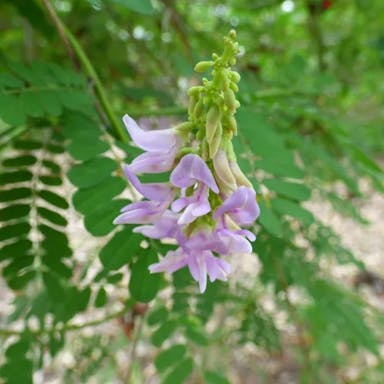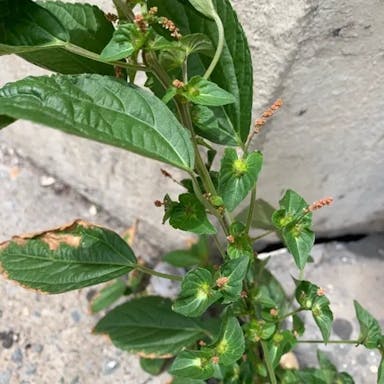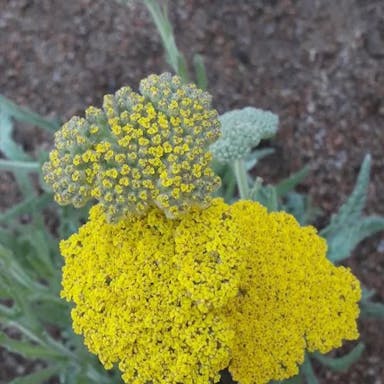Mother of thyme, also known as Thymus praecox, is a perennial plant that belongs to the Lamiaceae family. she is native to Europe and can be found in various regions, including the Mediterranean. This plant is known for its low-growing habit and forms dense mats of foliage. The leaves of Thymus praecox are small, oval-shaped, and have a gray-green color. They are highly aromatic and release a pleasant fragrance when crushed. Thymus praecox produces small, tubular flowers that are arranged in dense clusters. The flowers can vary in color, ranging from pink to purple. They bloom in late spring or early summer, attracting bees and other pollinators. This plant is classified as a subshrub, which means it has woody stems at the base and herbaceous growth above. Thymus praecox has several varieties, including 'Coccineus', which has bright red flowers, and 'Albus', which has white flowers. These varieties add diversity and visual interest to gardens and landscapes. In terms of fruit, Thymus praecox produces small, dry capsules that contain tiny seeds. These capsules are not typically used for culinary purposes. Thymus praecox is relatively easy to grow and is well-suited for rock gardens, borders, and ground covers. It prefers well-drained soil and full sun exposure. This plant is drought-tolerant and requires minimal maintenance once established. It can be propagated through division or by taking stem cuttings. Thymus praecox is valued for its ornamental qualities, culinary uses, and medicinal properties.
Mother of thyme
- Scientific name
- Thymus praecox
Basic Information
- Lamiaceae Family Thymus Genus Mother of thyme Species
- Lamiaceae > Thymus > Thymus praecox
- 83%
- The Completeness of This Encyclopedia
Please help us complete the encyclopedia, Terrarium is a encyclopedia service to be completed with everyone in the world. Currently, this page is 83% complete. For more information on how to contribute, please click here.
- Forb/herb
- Perennial
- Subshrub
- Height
- 10cm ~
- Flower Color
- Leaf Color
- Anthesis
- summer
- Sunlight Exposure
Full Sun Long hours of sunlight from morning to afternoon Partial Shade A location in the shade of a tree or where either the morning or afternoon is shaded Full Shade A place where there is no direct sunlight
- Full Sun
- Hardiness Zones
This is an indicator to know to which zone each plant can winter. Knowing the zone of each plant gives you an idea of the cold temperature resistance when grown in the ground without a roof. 2: -42.7 to -40.0 3: -39.9 to -34.4 4: -34.3 to -28.9 5: -28.8 to -23.3 6: -23.2 to -17.8 7: -17.7 to -12.2 8: -12.1 to -6.7 9: -6.6 to -1.1 10: -1.0 to 4.4 11: 4.5 to 10.0
- 4
- Cold resistance
- Excellent
- Heat resistance
- Fair
- Habitat of origin
- Europe
- Growth Rate
- Normal
What is Mother of thyme (Thymus praecox)?
What is Mother of thyme (Thymus praecox)
Flower meaning
The flower language associated with the plant known as Mother of thyme in America represents the attributes of power and valor. This symbolism conveys the notions of perseverance, courage, and decisiveness. It frequently communicates esteem and bolstering for a person confronting trials or problematic circumstances. The Mother of thyme, with its petite, sensitive blossoms and pungent fragrance, epitomizes conquering impediments and prospering notwithstanding antagonistic conditions. It fills in as a suggestion to remain hearty and determined when faced with difficulties.
Calendar of Mother of thyme (Thymus praecox)
Calendar
Mother of thyme, biologically classified as Thymus serpyllum, blooms vibrantly May through June. Deadheading faded blooms prolongs the season. Full sun exposure in well-drained soil provides optimal growth. Found east and central United States, the aromatic herb attracts pollinators. Extended flowering displays beautifully in gardens. Originating Europe and North Africa, it is a perennial. For more blooms, remove spent flowers regularly. Sun and drainage are key. Bees and butterflies flock to the long-lasting color. Fertile soil sustains the herb’s growth.
How to grow Mother of thyme (Thymus praecox)
Watering
The optimal frequency and method of watering for the plant named Mother of thyme depends on various factors, including seasonal differences, soil humidity, and the specific growth stage of the plant. During the growing season, which typically occurs in spring and summer, Mother of thyme requires regular 2-inch watering once a week to maintain soil moisture. In contrast, during the dormant season in fall and winter, the watering frequency should be reduced to prevent overwatering. The plant deeply needs monitoring the soil moisture level and adjusting the watering accordingly to avoid water stress .
Soil and Fertilizer
Mother of thyme populations remains scientifically known as Thymus serpyllum. Chosen sandy living materials supply well-drained quality properties enjoying important full exposure. Nutrient content necessitates springtime application guidance. Seasonal testing procedures encourage monitoring developing conditions. Following sustainable procedures supports optimal progress.
Sunlight and Place
Mother of thyme, a plant commonly known as Thymus serpyllum, is a perennial herb that thrives in full sun exposure. It is highly tolerant to both cold and heat, making it suitable for a wide range. The optimum temperature for Mother of thyme is between 60 to 70 degrees Fahrenheit (15 to 21 degrees Celsius). During the summer, it is important to provide adequate water to prevent the plant from drying out. In colder regions, it is recommended to mulch the plant during winter to protect it from frost. Mother of thyme should be placed in a location that receives at least 6 to 8 hours of direct sunlight per day. Overall, Mother of thyme is a resilient plant that thrives in sunny conditions and can withstand a wide range. Wintergreen is an evergreen plant that spreads by underground stems called rhizomes. The glossy, leathery leaves remain green throughout winter. It grows best in moist, acidic soil and partial shade, though tolerates full sun. White flowers bloom from May to July. The edible bright red berries appear in late summer and fall. All parts of wintergreen contain methyl salicylate, the main ingredient in many muscle rubs. Tea made from wintergreen leaves has a minty flavor and has traditionally been used to treat headaches, fever, indigestion, arthritis and gout.
Advanced Information of Mother of thyme (Thymus praecox)
Pruning
Mother of thyme, scientifically known as Thymus serpyllum, benefits from regular pruning and cutting back to maintain its shape and promote healthy growth. After early spring or after summer flowering, use clean pruning shears to cut back stems, remove dead parts, and prevent aggressive spreading. Cutting promotes new growth, removes damaged stems, and prevents woodiness. Pruning controls size and shape. Apply mulch after cutting to retain moisture and suppress weeds. Regular pruning makes mother of thyme compact, attractive, vigorously growing, and abundantly flowering.
Planting and Harvest
Mother of thyme, too known Thymus serpyllum, is permanent plant can be potted or planted on soil. When pot Mother of thyme, select box with good flow and fill it with well-flow soil. Put the factory in the pot, creation confident the crown is grade with the soil facade. Irrigate the factory completely later potting and hold the soil evenly moist. If implanted in the ground, elect a sunny point with well-flow soil. Make the implanted area by extermination weeds and slacken the soil. Dig an opening somewhat bigger than the root ball and put the factory in the hole, creation confident the crown is grade with the soil facade. Backfill the hole with soil, firming it softly circumambient the factory. Irrigate the factory completely later implanted and hold the soil moist until it befits ingrained. To repot Mother of thyme, opt a somewhat bigger box and trail the same pot process as said earlier. Repotting is normally finished every 2-3 years or when the factory outgrows its modern box. Mishowing, or misplacement, of Mother of thyme can happen if it is not supposing the proper growing provisions. This factory prefers full sun and well-flow soil, so it should not be put in shady or waterlogged areas. Additionally, overwatering can lead to root rot, so it is main to agree to the soil to dry out between irrigations.
Propagation
Mother of thyme requires propagation through various methods such as sowing seeds, division, cuttings, and leaf cuttings. To propagate through sowing seeds, collect mature seeds and sow them in well-drained soil. Keep the soil moist and provide indirect sunlight. For division, carefully separate the plant into smaller sections, ensuring each section has roots attached. Plant the divisions in separate containers or directly in the ground. To propagate through cuttings, take stem cuttings from healthy plants and remove the lower leaves. Dip the cut end in rooting hormone and plant it in a well-draining potting mix. Leaf cuttings can also be used for propagation. Take healthy leaves and place them in a tray with moist soil. Keep the tray in a warm and humid environment until roots develop. Harvesting requires cutting the stems just above the ground level. By using multiple propagation methods, you can increase the chances of successful propagation and obtain a larger number of new plants.
Pests and Diseases
Mother of thyme (Thymus serpyllum), an herb plant, can have issues with tiny insects called thrips that eat its leaves and flowers. Thrips can hurt the plant by sucking its juices, making the leaves change color and look weird. To stop thrips from coming, you need to check the plant a lot and find thrips early. Soapy water or oils can also help with thrips. Another tiny bug that goes after Mother of thyme is the spider mite. These tiny spiders suck the juice out of the plant, making the leaves turn yellow with little dots. Spider mites like it when it's dry, so you should try to keep the air humid around the plant and mist it a lot. That can help stop spider mites. If it's really bad, you might need to use spray made to kill bugs. Mother of thyme can also get root rot from too much water or soil that doesn't drain well. Root rot makes the plant wilt, turn yellow, and sometimes die. To avoid root rot, the soil needs to drain well and you can't overwater. Letting the soil dry out between watering is good. So in summary, Mother of thyme can have problems with pests like thrips and spider mites, and diseases like root rot. You need to watch the plant closely, find problems early, and take good care of it to prevent issues.
Habitat of Mother of thyme (Thymus praecox)
Habitat
Toxicity of Mother of thyme (Thymus praecox)
Health Benefits
- edible
- edible
- Toxic
- No toxicity
NO DATA
Toxic for dogs and cats
NO DATA
Q&A of Mother of thyme (Thymus praecox)
- Is there a recommended way to choose Mother of thyme?
Mother of thyme (Thymus praecox) is a low-growing and spreading plant. Choosing varieties with different flower colors and fragrances can meet aesthetic preferences. When buying seeds, check for freshness and high germination rates. If buying seedlings, inspect for health and well-developed roots. Careful selection allows successful gardening.
- Mother of thyme vs creeping thyme: Which is better for your garden?
Both Mother of Thyme (Thymus praecox) and Creeping Thyme are excellent choices for your space, but the optimal selection depends on your precise requirements. Mother of Thyme is a hardy, low-growing all year lasting plant that spreads quickly, making it perfect for ground protection or filling gaps between stepping rocks. It also has a nice fragrance and can bring pollinators to your space. On the other hand, Creeping Thyme is slightly more drought-tolerant and can handle people walking on it better than Mother of Thyme. Therefore, if your space is in a dry area or if the plants will be walked on frequently, Creeping Thyme may be the superior choice.
- How to grow mother of thyme from seeds?
To grow Mother of Thyme (Thymus praecox) from seeds, start by sowing the seeds indoors 6-8 weeks before the last expected frost. The seeds should be lightly covered with soil and kept in a warm, well-lit area. After the seedlings have developed their second set of true leaves, they can be moved outside. Select a place with well-draining soil and full sun. Keep in mind, Thymus praecox is a hardy, low-growing perennial that grows well in rocky or sandy soils, and it can handle drought once established.
- How to grow a mother of thyme lawn?
To cultivate a Mother of Thyme (Thymus praecox) lawn, start by selecting a sunny location with well-drained soil. This requires full sun and can tolerate poor, rocky soil conditions. Prepare plant cover area by removing any existing masses or weeds, then loosen using a fork or tiller. Scatter evenly over region and lightly cover with soil. Give plenty of water and keep moist until they start growing, which is typically 14 to 28 days. Once started, Mother of Thyme needs minimal care, but period give water during periods without rain will help it thrive. Remember, this grows slowly, so patience is key. Over time, it will form a thick aromatic plant covering that's resistant to periods without rain and walking on it.












